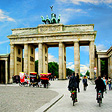THE BERLINER DOM
Berlin's Court Cathedral Church and Hohenzollen Crypt
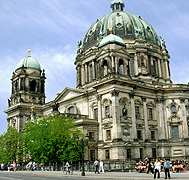 The
cathedral in the center of Berlin, as the great city cathedrals of Europe
go, is a recent addition to the German Capital. A series of churches
had stood on the spot along the Spree River where the current cathedral
stands on the Museum Island, all originally part of the ruling royal
Hohenzollerns royal palace, first established by Prince Elector Frederick
II, who moved his court from Brandenburg to Berlin in the 1454. Where
the palace once spread out on the other side of the Unter Den Linden
from the Dom, surrounded by the formal Baroque Lustgarten, now a massive
construction project is underway, the
The
cathedral in the center of Berlin, as the great city cathedrals of Europe
go, is a recent addition to the German Capital. A series of churches
had stood on the spot along the Spree River where the current cathedral
stands on the Museum Island, all originally part of the ruling royal
Hohenzollerns royal palace, first established by Prince Elector Frederick
II, who moved his court from Brandenburg to Berlin in the 1454. Where
the palace once spread out on the other side of the Unter Den Linden
from the Dom, surrounded by the formal Baroque Lustgarten, now a massive
construction project is underway, the 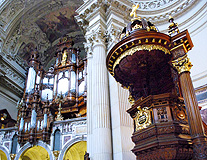 Berlin Palace of the Prussian rulers
leveled by bombs at the end of WWII. The last royal church on the spot
was not grand enough for the Kaiser Wilhelm II, who imagined a protestant
German Empire as great as claimed ancestor Charlemagne (see Hohenzollern
Black Forest Castle). Wilhelm ordered the old church torn down in 1894
and a new cathedral built to rival St. Peters Basilica in Rome. The present
Berliner Dom designed in Neo High-Renaissance style with Baroque elements
by Julius Karl Raschdorff was completed in 1905 and colloquially called
the “Protestant St Peters”.
Berlin Palace of the Prussian rulers
leveled by bombs at the end of WWII. The last royal church on the spot
was not grand enough for the Kaiser Wilhelm II, who imagined a protestant
German Empire as great as claimed ancestor Charlemagne (see Hohenzollern
Black Forest Castle). Wilhelm ordered the old church torn down in 1894
and a new cathedral built to rival St. Peters Basilica in Rome. The present
Berliner Dom designed in Neo High-Renaissance style with Baroque elements
by Julius Karl Raschdorff was completed in 1905 and colloquially called
the “Protestant St Peters”.
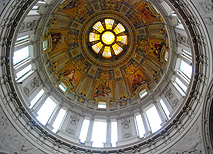 A
true Baroque domed church had stood on the spot since 1750, designed
by Johann Boumann the Elder for Frederick the Great, with the burial
tombs of the Hohenzollern Prince-Electors underneath. By Wilhelm II’s
grand plan, the tombs were removed and the old church demolished for
his expression of the power of the new German Empire. A dream dashed
by defeat in World War I. Wilhelm’s great cathedral lasted for
only 40 years until the bombing of Berlin in the Second World War. One
British bomb hit near the church in the night bombings of 1940, blasting
out the stained glass windows. Then in 1944, during the heavy daylight
bombing of Berlin an incendiary bomb made a direct hit, setting off a
fire which weakened the dome support, collapsing the dome. The church
sat in rubble for much of the East German socialist period until reconstructions
began in the late 1960s.
A
true Baroque domed church had stood on the spot since 1750, designed
by Johann Boumann the Elder for Frederick the Great, with the burial
tombs of the Hohenzollern Prince-Electors underneath. By Wilhelm II’s
grand plan, the tombs were removed and the old church demolished for
his expression of the power of the new German Empire. A dream dashed
by defeat in World War I. Wilhelm’s great cathedral lasted for
only 40 years until the bombing of Berlin in the Second World War. One
British bomb hit near the church in the night bombings of 1940, blasting
out the stained glass windows. Then in 1944, during the heavy daylight
bombing of Berlin an incendiary bomb made a direct hit, setting off a
fire which weakened the dome support, collapsing the dome. The church
sat in rubble for much of the East German socialist period until reconstructions
began in the late 1960s.
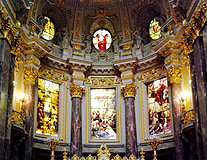 Like the Frauenkirche in Dresden (see Dresden's
Frauenkirche Reconstructed),
as a protestant cathedral of the post Baroque age in Germany, the Berlin
Dom is nearly square, foregoing the long nave and transepts of the cross
shape of earlier Catholic gothic cathedrals, with seating on levels in
galleries under the central dome. The main altar of the Berliner Dom
dates from 1850. The reconstructed dome ceiling is intricately decorated
with mosaic tiles and can be viewed with closer inspection from the gallery.
A climb of 270 steps lead to the top with stairwell landings lined with
historic photos and models of the various incarnations of the church.
The magnificent pipe organ constructed by Wilhelm Sauer, which can been
seen in pictures of war damage sitting in a pile of the fallen dome's
rubble, was restored during reconstruction. A golden altar frieze depicting
the twelve apostles created by K. F. Schinkel, glows above the prayer
hall.
Like the Frauenkirche in Dresden (see Dresden's
Frauenkirche Reconstructed),
as a protestant cathedral of the post Baroque age in Germany, the Berlin
Dom is nearly square, foregoing the long nave and transepts of the cross
shape of earlier Catholic gothic cathedrals, with seating on levels in
galleries under the central dome. The main altar of the Berliner Dom
dates from 1850. The reconstructed dome ceiling is intricately decorated
with mosaic tiles and can be viewed with closer inspection from the gallery.
A climb of 270 steps lead to the top with stairwell landings lined with
historic photos and models of the various incarnations of the church.
The magnificent pipe organ constructed by Wilhelm Sauer, which can been
seen in pictures of war damage sitting in a pile of the fallen dome's
rubble, was restored during reconstruction. A golden altar frieze depicting
the twelve apostles created by K. F. Schinkel, glows above the prayer
hall.
The Hohenzollen Crypt
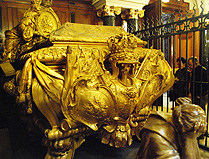 One of the more unique and historically significant features of the Berliner
Dom is the royal crypt of the Prussian and Brandenburg rulers underneath,
with golden tombs and ornate filigree of images of death and homage.
Perhaps not as grand and fresh as the Habsburg Kaisergurft tombs in Vienna
(see Vienna
Habsburg Crypt) where fresh flowers are
still laid in remembrance of a gloried past, and no war damage to contend
with.
Though the Hohenzollerns
came out on top of the German power plays between the Prince Elector
states and fifedoms of the 17th and 18th Centuries, the fortunes of the
20th Century were not so glorious.
One of the more unique and historically significant features of the Berliner
Dom is the royal crypt of the Prussian and Brandenburg rulers underneath,
with golden tombs and ornate filigree of images of death and homage.
Perhaps not as grand and fresh as the Habsburg Kaisergurft tombs in Vienna
(see Vienna
Habsburg Crypt) where fresh flowers are
still laid in remembrance of a gloried past, and no war damage to contend
with.
Though the Hohenzollerns
came out on top of the German power plays between the Prince Elector
states and fifedoms of the 17th and 18th Centuries, the fortunes of the
20th Century were not so glorious.
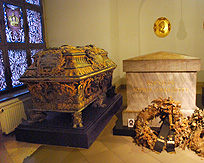 The crypt
under the Dom where many of the Hohenzollerns are buried, was damaged
when the dome fell, and
several of
the coffins
burned. The crypt
was
restored and reopened in 1999 after the reunifaction of Germany. Some
of the destroyed gold gilt coffins have been replaced by more sedate
marble forms, including those of Frederick the Great and Queen Sophie
Charlotten, and several coffins in the crypt are still
undergoing
restoration.
The royal
Hohenzollern
crypt
in Berlin
is a little
dark
and shows some
of the signs of wear, but the 94 entombed princes, queens and monarchs
is still an impressive vestige of the royal age. Where the Habsburgs
still are a current royal family with some branches still the heads
of state (see Prince
of Liechtenstein Vineyards), the Hohenzollerns have
rathered retired to more historical anonimity.
The crypt
under the Dom where many of the Hohenzollerns are buried, was damaged
when the dome fell, and
several of
the coffins
burned. The crypt
was
restored and reopened in 1999 after the reunifaction of Germany. Some
of the destroyed gold gilt coffins have been replaced by more sedate
marble forms, including those of Frederick the Great and Queen Sophie
Charlotten, and several coffins in the crypt are still
undergoing
restoration.
The royal
Hohenzollern
crypt
in Berlin
is a little
dark
and shows some
of the signs of wear, but the 94 entombed princes, queens and monarchs
is still an impressive vestige of the royal age. Where the Habsburgs
still are a current royal family with some branches still the heads
of state (see Prince
of Liechtenstein Vineyards), the Hohenzollerns have
rathered retired to more historical anonimity.
Visiting the Berlin Dom Cathedral
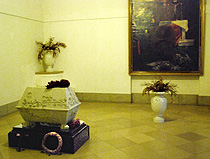 Entrance
to the Berlin Dom Cathedral and the Hohenzollern Crypt (Die Kurfürsten
Gruft Hohenzollerns) is €7 for Adults, €4 for
students and Seniors, and free for children. Admission is includeded
with a Berlin
Welcome Card. A visit to the Dom is easily combined with
the museums of the Museum Insel,
(see Nefertiti
at the Neues Museum, Bode Museum Byzantine and Pergamon
Museum) and the DDR Museum (see Socialist Life
at DDR Museum), just across the river. © Bargain
Travel Europe
Entrance
to the Berlin Dom Cathedral and the Hohenzollern Crypt (Die Kurfürsten
Gruft Hohenzollerns) is €7 for Adults, €4 for
students and Seniors, and free for children. Admission is includeded
with a Berlin
Welcome Card. A visit to the Dom is easily combined with
the museums of the Museum Insel,
(see Nefertiti
at the Neues Museum, Bode Museum Byzantine and Pergamon
Museum) and the DDR Museum (see Socialist Life
at DDR Museum), just across the river. © Bargain
Travel Europe
Find best hotel and vacation deals in Berlin on TripAdvisor
Web Info
Visit
Berlin
These articles are copyrighted and the sole property of Bargain Travel Europe and WLPV, LLC. and may not be copied or reprinted without permission.
See Also:
KAISER WILHELM MEMORIAL CHURCH
CHECKPOINT CHARLIE WALL MUSEUM
BENDLERBLOCK - NAZI RESISTANCE MEMORIAL
DALI EXHIBITION - SURREALISM AT POTSDAMER PLATZ

